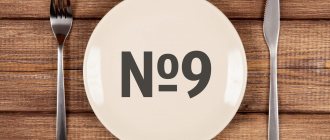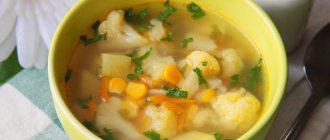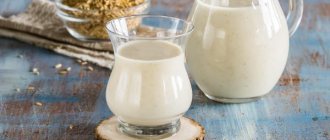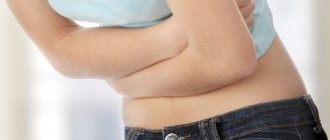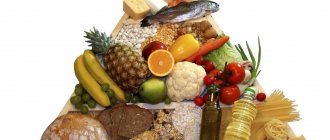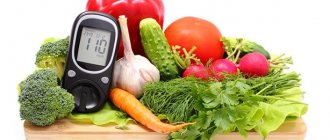11/27/2019 Article
- general characteristics
- Table "Do's and Don'ts"
- Menu for the week
The indication for the use of the “8 table” diet is varying degrees of obesity in conditions of performing mental or physical labor. When prescribing a diet, there should be no complications from the digestive organs, circulatory system and other systems requiring special diets.
Types of diet
Medical nutrition "Table 8" has two additional subtypes No. 8A and No. 8B:
- Table No. 8A for weight loss is prescribed to patients who do not have diseases or complications that require a special diet. The diet involves a more stringent restriction of the caloric content of foods included in the diet - up to 1300 kcal per day.
- Table No. 8B is prescribed for patients with concomitant heart diseases. It differs from the main diet in the complete absence of table salt in portioned foods.
Who is it suitable for?
Diet, or, as it is also called “table”, No. 8 is used to treat obesity of all three stages. It can be prescribed by a doctor or used independently. It is important to consult a doctor before starting the course, as the technique has some contraindications. It should not be combined with other therapeutic diets and is allowed when taking medications.
Content:
- Who is it suitable for?
- Nutrition rules
- Diet foods: what you can, what you can’t
- Menu for table No. 8
- Finally
For self-correction of the figure, the “eighth” diet can be used if there are no diseases of the gastrointestinal tract. If such diseases are present, the doctor prescribes another program - treatment tables No.: , , , . The limited intake of these diets is aimed at improving health and also leads to weight loss.
Obesity may be a consequence of another disease, in which case only a therapist can determine which diet is more important for the patient's health.
A specially selected diet of diet No. 8 helps to normalize metabolism and break down the subcutaneous fat layer.
Advantages and disadvantages
Like any therapeutic food, “Table 8” has positive and negative sides:
- Pros: a balanced diet gives a person a feeling of fullness, despite the low calorie content of foods. Abundant consumption of fiber with dietary fiber of plant origin promotes good digestion and normalizes metabolism in the human body.
- Cons: since carbohydrates stimulate the production of serotonin (“the hormone of joy”), their insufficient consumption often causes loss of energy, irritability, pessimism and a negative attitude towards life in patients.
Recommended cereals include:
- buckwheat;
- pearl barley;
- Brown rice;
- barley
Semolina, oatmeal or white rice should be added to the diet with caution.
Do not overuse potatoes and legumes. For dietary nutrition, it is recommended to eat low-fat meat:
- birds;
- young beef;
- rabbit meat.
From seafood you should choose the following types of fish:
- bream;
- zander;
- whiting;
- cod;
- carp.
It is recommended to boil, stew or bake meat and fish. The best processing method is steaming. It is recommended to eat eggs boiled and in omelettes with water or low-fat milk. Fried foods should be completely excluded from your diet. The norm for dishes containing animal fats is no more than 150 g per day.
Diet table nutrition rules 8.
It is recommended to limit the consumption of cheeses, including them in the menu no more than 1-2 times a week. Low-fat cottage cheese with a fat mass of up to 1.5%, an omelet from 2 eggs are allowed for consumption. You will have to give up sweet curds and yoghurts.
It is also advisable to limit the consumption of bread.
Small portions of baked goods made from wholemeal flour with added bran are allowed. The consumption of baked goods and baked goods made from wheat flour is strictly prohibited. It is advisable to completely exclude the consumption of sweet berries and fruits from the diet:
- grapes;
- pears;
- strawberries;
- cherries;
- bananas
It is recommended to eat sweet and sour fruits raw:
- oranges;
- lemons;
- grapefruits;
- apples;
- kiwi;
- pineapples;
- lime
Recommended drinks on the Table 8 diet:
- unsweetened tea with milk;
- compotes and fruit drinks without sugar;
- still mineral water without salt;
- fresh fruit and vegetable juices.
The main taboo applies to foods that stimulate the appetite, such as sweet and high-calorie desserts, spicy seasonings, smoked foods, marinades and pickles. Alcoholic drinks, cocoa, sweet tea and coffee, milkshakes, soda and lemonade are strictly prohibited.
List of prohibited products.
Diabetes mellitus, nutritional features
Very often, a significant increase in body weight is a consequence of a diagnosis such as type 2 diabetes. Table No. 8 is often one of the main components of complex treatment of the disease, which, if strictly followed, does not even require drug therapy.
During the diet, patients learn to control the size of portions consumed and instill proper eating habits.
For patients diagnosed with diabetes, in parallel with a low-calorie diet, the doctor prescribes mandatory physical activity. Their activity is regulated depending on the general condition, lifestyle, percentage of obesity and age of the patient.
Diabetes mellitus in children
A disease such as diabetes manifests itself due to disruptions in the functioning of hormones not only in adults, but also in children of any age.
In the case of a chronic metabolic disorder in a child, the Pevzner table should be followed by the whole family. Diabetes mellitus in children most often occurs due to uncontrolled consumption of sweets, flour and fatty foods. You can’t feed yourself on mashed potatoes in butter, fatty chicken legs and high-calorie cakes, while at the same time “stuffing” boiled chicken breast with broccoli and cucumbers into your child. For children, it is their mothers and fathers who are idols and role models. Therefore, diet No. 8 can only be followed by children together with their parents.
The most difficult thing for children diagnosed with diabetes is giving up sweets. In all large supermarkets there is a special section with diabetic products, where you can sometimes buy sorbitol cookies or fructose chocolate for your child.
Diet for children
Overweight children should not be given sweet fruit drinks, compotes and cocktails.
They are replaced with freshly squeezed juices and dried fruit compotes without sugar. It is recommended to eat sweet and sour fruits and berries. The child's main diet consists of pureed soups and vegetable dishes. All food should be boiled or steamed. Cereals, legumes and potatoes are consumed in limited quantities. Preference is given to buckwheat and millet porridge. Adding bran to food has a beneficial effect on treatment.
It is forbidden to give an obese child sweet desserts and confectionery, baked goods made from wheat flour, sweet and carbonated drinks. Instead of sugar, xylitol is added to tea, but not more than 25 g per day.
Feeding the baby is divided into 5 meals, in small portions. The main part of the daily diet occurs in the first half of the day, the last meal is 2.5-3 hours before bedtime.
Food for the child.
pros
1. Your body will not be subject to severe stress, because it will have enough time to completely get used to the new nutrition system and new lifestyle; 2. In order to maintain the results of the entire diet for a long time, you need to adhere to certain instructions for exiting it. In this case, the lost weight will not return and you will remain in the achieved shape; 3. During the diet, you and your body will completely rebuild all your habits, develop new useful habits, because of which you will adhere to proper nutrition and lifestyle in the future; 4. Due to the sufficient duration of the diet, you will not need to sweat for hours in the gym, because during this period you will have time to lose weight and get in shape without heavy training; 5. Together with your doctor, you can find and select an individual nutrition system for yourself, from those that are designed for no more than a month.
Dish recipes
1. Fresh vegetable salad with cheese.
Compound:
- lettuce leaves - 50 g;
- basil - 50 g;
- tomatoes - 2 pcs.;
- radishes 4 - pcs.;
- fresh cucumber - 2 pcs.;
- green onions - 50 g;
- olives - 1 jar;
- feta cheese - 150 g;
- lemon - 0.5 pcs.;
- olive oil - 2 tbsp.
Cooking instructions:
- Cut basil, onion and lettuce into strips.
- Cut vegetables and cheese into equal cubes.
- Add the olives, cut in half, and mix carefully, without crushing the pieces of cheese.
- Pour in olive oil and a few drops of lemon juice.
2. Stewed turkey with carrots and sour cream.
Compound:
- turkey meat - 500 g;
- carrots - 2 pcs.;
- onions - 1 pc.;
- 10% sour cream - 0.5 tbsp.;
- vegetable oil - 1 tsp;
- flour - 1 tbsp;
- spices to taste.
Cooking instructions:
- Fry onions cut into half rings in vegetable oil.
- Cut the carrots into small cubes and add to the onion with a little water. Simmer over low heat for 5 minutes.
- Sprinkle turkey pieces with spices and place in a frying pan with onions and carrots. Simmer until the meat turns white.
- Place everything in a high frying pan, add boiling water, covering the meat, and simmer for 8 minutes.
- Add sour cream, reduce heat to low and cook for half an hour.
- Add flour, stirring until dissolved, and simmer for 3-5 minutes.
Menu for table No. 8
If before the diet the diet was far from healthy, the menu needs to be adjusted gradually. First, you will have to give up fatty and fried foods, then remove flour and sweets from your diet, and at the last stage you should reduce the amount of salt and dairy products.
The menu for the week can be planned in advance, based on the available set of products. In addition, if you place a written diet plan in a visible place, the likelihood of a breakdown decreases. Let's consider an approximate diet for an average daily load (1800 kcal).
Monday
Breakfast: unsweetened oatmeal cookies, coffee without sugar, one apple.
Lunch: a glass of natural tomato juice.
Lunch: soup with broccoli, bell peppers and chicken, whole grain bread (1 slice).
Afternoon snack: seaweed (100 g), tea.
Dinner: one baked potato, one boiled egg, tomatoes, a glass of berry juice.
Tuesday
Breakfast: crumbly buckwheat, tomatoes, coffee or tea.
Lunch: a glass of kefir, some nuts.
Lunch: vinaigrette without potatoes, diet bread, citrus juice.
Afternoon snack: salad of cucumbers and herbs.
Dinner: steamed cutlets, light salad, chamomile or rosehip infusion.
Wednesday
Breakfast: fruit salad with flaxseeds, coffee or tea.
Lunch: “empty” yogurt or cottage cheese.
Lunch: rassolnik or green borscht, a piece of rye bread.
Afternoon snack: a piece of hard cheese, tea or herbal decoction.
Dinner: veal or beef aspic, natural juice.
Thursday
Breakfast: boiled egg, cucumber, tomato and herb salad, hot drink.
Lunch: one orange or grapefruit.
Lunch: soup with chicken meatballs and vegetables.
Afternoon snack: a handful of nuts, tea.
Dinner: vegetarian cabbage rolls, a little sour cream, freshly squeezed juice.
Friday
Breakfast: oatmeal with water, one piece of toast with cottage cheese and herbs, tea.
Lunch: two baked apples, rosehip infusion.
Lunch: creamy broccoli and potato soup.
Afternoon snack: berry jelly, tea with milk.
Dinner: stewed cabbage with carrots and prunes, a glass of curdled milk.
Saturday
Breakfast: millet porridge, one pear or apple, coffee.
Lunch: rye bread crackers, a glass of milk.
Lunch: fish soup, a piece of black bread.
Afternoon snack: a glass of yogurt.
Dinner: stew of zucchini, tomato and eggplant, separately a few pieces of mozzarella.
Sunday
Breakfast: steamed scrambled eggs, salad of lettuce and celery.
Lunch: dried apricots, rosehip decoction.
Lunch: vegetarian borscht, separately a piece of boiled veal.
Afternoon snack: a mix of lettuce leaves, grapefruit and sesame seeds.
Dinner: grilled or oven-baked carp, celery and cucumber salad.
It is important to take into account your own physical needs when creating a menu. If the planned food is not enough, you feel severe weakness or dizziness, you need to add more plant and protein foods to the menu.
The results will be more effective if morning coffee is replaced with rosehip decoction or green tea; it is also permissible to use a chicory drink. Preparing low-calorie food will take time; you can prepare one dish for two or three servings to reduce your time in the kitchen. Various kitchen appliances will be useful assistants: a multicooker, a juicer, food processors, etc. Although, as reviews note, with the help of a regular grater and oven, dishes are no worse.
Orange cream soup can be prepared using a blender or simply pureed through a sieve. In a saucepan you need to boil one onion, 200 g of pumpkin and one potato well. Beat the prepared vegetables (or grate them), you can add 100 ml of milk and finely chopped greens. When serving, you can separately cut the boiled chicken fillet into pieces and sprinkle it over the soup.
Best materials of the month
- Coronaviruses: SARS-CoV-2 (COVID-19)
- Antibiotics for the prevention and treatment of COVID-19: how effective are they?
- The most common "office" diseases
- Does vodka kill coronavirus?
- How to stay alive on our roads?
Unsweetened cookies can solve the problem of dietary breakfasts or snacks. You need to grate one apple, add one beaten egg white to it and mix well. Add 1 cup of previously soaked oatmeal there and knead the dough. The workpiece must be kept in the refrigerator for half an hour. Then place the future cookies on parchment and place in the oven for 25 minutes (at 180 degrees).
There are many options for dietary dishes. Over time, the basic rules of the diet will be remembered and recipes can be easily invented on your own.
You can adhere to diet No. 8 according to Pevzner until the required weight is established. The technique is long-term; the average duration of excess weight adjustment takes an average of six months. A gradual decrease in body weight on such a diet allows you to maintain the achieved result for a long time, because the therapeutic technique allows you to gently and stress-free adjust your metabolism. This distinguishes table No. 8 from many strict diets.
Patient reviews
Anna, 26 years old, Kazan: “As a child, I was always chubby, but it didn’t bother me.
When all my friends started families, and men didn’t pay attention to me, this became a problem. Six months ago I learned about diet No. 8 according to Pevzner. The excess weight began to disappear little by little. Before I went on a diet, I weighed 92 kg, now the scales show 81, and, most importantly, the weight remains stable.” Maria, 31 years old, Tuapse: “In my youth I was slim, my weight was always within the range of 54-56 kg. After the birth of my second daughter, I gained 40 kg and for a long time could not return to normal. On the doctor’s advice, I went on the “Table No. 8” diet. After just two months I lost 8 kg. There are no strict restrictions in this diet; it is balanced and quite nutritious, despite the low calorie content of the recommended foods.”
Minuses
1. Not for everyone, a month of abstinence from usual foods and following a strict diet becomes a feasible test, so there are frequent cases when people break off the diet; 2. Moreover, the harder it becomes to follow a diet, the more holidays there are during it, when there are so many temptations and temptations around us; 3. In addition to all of the above, weight does not always come off evenly. Sometimes it may hardly decrease at all, or even stand still. It is because of this that many people who are losing weight give up due to nervousness, lose all motivation to lose weight and stop the diet without achieving any significant results; 4. Losing weight always becomes a sacrifice, which is far from easy to bear.
Basic recommendations
- Dietary table number 8 according to Pevzner implies a complete abstinence from sugar. Only sweeteners such as xylitol are used.
- Reduces the amount of carbohydrates and fats
- Dishes can be prepared using any culinary method, except frying. Before frying a meat product, it must be boiled
- Number of calories per day – 1700
- Meals per day – 5-6
- Menu for week 8 diet for obesity involves reducing the amount of salt (5-6 grams per day)
- The amount of fluid per day is also reduced - one liter
- Any food temperature
Comments from nutritionists
One of the main mistakes is made by those patients who, due to obesity, strive to lose weight in the shortest possible time. Many physiologically inferior and unbalanced diets (mono-diets) are advertised on the Internet, promising rapid weight loss in case of obesity, however, as practice shows, weight is also quickly restored to the original level, and often exceeds it. At the same time, general well-being often suffers. It is a balanced energy-reduced diet that is much more effective than such diets. And in this regard, the Soviet therapeutic Diet No. 8 according to Pevzner is especially effective. That is, a diet for losing weight should not be hungry.
The timing of diet therapy is individual and depends on many factors, but in any case, dietary therapy involves a long period of being on a diet. It is generally accepted that the normal rate of weight loss is 1% per week of your own weight. An indicator of the correctness of dietary nutrition is not only a decrease in body weight, but also the resulting increase in neuromuscular tone and improvement in overall well-being.
Following a diet without adequate physical activity cannot lead to significant weight loss. Physical activity will help prevent metabolism from adapting to new nutritional conditions, maintain muscle mass and reduce energy balance. However, the load must be exactly adequate to your physiological capabilities, since excessive physical activity has the opposite effect. It is recommended to walk 3-10 km per day, which can be combined with swimming or cycling.
It is extremely important to change eating behavior. Most overweight people view eating as a pleasure and often go to the refrigerator not for the purpose of satiation, but in order to cope with a traumatic/stressful situation or improve their mood, occupy boredom, relieve feelings of loneliness, melancholy, apathy, anxiety , depression . Therefore, in addition to motivation, it is important to have and maintain a certain psychological attitude, for which you need to use group psychotraining, autogenic training, and hypnosis.
Don't set too high goals for yourself. If weight loss occurs through violence against your body with feelings of hunger, discomfort, dissatisfaction with yourself, the result will always be negative, either in the form of a psychological breakdown or in the form of a return of weight to the original level.
Restoring weight to the original one or exceeding the original one during forced weight loss occurs quite often, especially with mono-diets. This phenomenon is called weight cycling and all the links in it condition each other:
- weight loss phase;
- lower plateau - weight no longer decreases, despite all ongoing efforts;
- weight gain phase;
- upper plateau - weight stabilizes again at the original level or slightly higher than the original level.
It is “comfortable” weight loss with a smooth weight loss without jumps that guarantees that the weight will not return again after completing the course.
Instead of an afterword
Whatever diet you choose for weight loss, you should take into account that when fats are broken down, the toxins stored in these fats are intensively released into the blood, poisoning an already stressed body. Time-tested enterosorbent No. 1 - Enterosgel - a universal remedy for cleansing and detoxifying the body will help you safely remove waste and toxins. It will bind and remove all harmful substances from the body, thanks to its special structure while preserving beneficial substances and microelements.
Be healthy!
